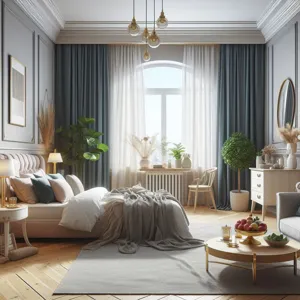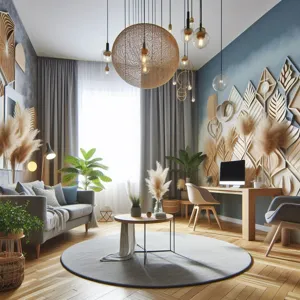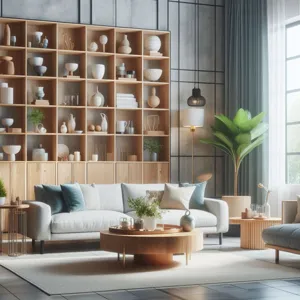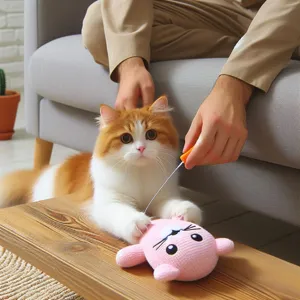Selecting the perfect furniture for your living room is more than just a matter of aesthetics; it’s about creating a space that reflects your personal style while also providing comfort and functionality.
As the heart of your home, the living room serves as a gathering place for family and friends, a haven for relaxation, and a canvas for your creativity. With countless options available—from sleek modern designs to cozy traditional pieces—navigating the world of furniture can feel overwhelming. In this blog post, we will unravel essential tips that will guide you in choosing the ideal furniture for your living room, ensuring that it harmonizes with your lifestyle, complements your decor, and meets your practical needs. Get ready to transform your space into a stylish and inviting retreat that perfectly balances form and function!
1. Assessing Your Living Room Space

When it comes to selecting the perfect furniture for your living room, the first step is to thoroughly assess your space. This foundational task not only lays the groundwork for a harmonious design but also ensures that your chosen pieces will fit seamlessly into your home.
Start by measuring the dimensions of your living room, taking note of the length and width of walls, doorways, and any architectural features like windows or fireplaces. Use a measuring tape and jot down these figures, as you’ll want to have them on hand when shopping. Consider the height of your ceilings too; a room with high ceilings can benefit from taller furniture pieces or vertical elements, while a cozy space might feel more intimate with lower profiles.
Next, think about the room’s layout and how you intend to use the space. Visualize how you want to arrange the furniture for optimal flow and functionality. Do you envision hosting gatherings with family and friends, or is your living room a quiet retreat for relaxation and solitude? This will influence your choices in terms of the size and type of furniture. For instance, a sectional sofa may be perfect for socializing, while a couple of plush armchairs could create a more intimate setting.
Also, consider the natural light that floods your living room throughout the day. This will affect not only the colors and materials you choose but also the placement of furniture. Pieces that are positioned to take advantage of light can become focal points, enhancing the overall ambiance.
Finally, don’t overlook the importance of visual balance in your space. A well-assessed living room should have a mix of heights, shapes, and textures that create a pleasing aesthetic. By taking the time to accurately assess your living room space, you can make informed decisions that will lead to a beautifully coordinated and functional environment where you and your guests will love to spend time.
2. Defining Your Style: Modern, Traditional, or Eclectic?
When it comes to furnishing your living room, one of the most crucial steps is defining your style. This foundational decision will shape not only the aesthetics of your space but also its overall atmosphere. Are you drawn to the clean lines and minimalism of modern design, or do you find comfort in the warmth and richness of traditional styles? Perhaps you’re an adventurous soul who thrives in the quirky, layered vibes of eclectic decor.
**Modern Style:** If sleek, contemporary aesthetics resonate with you, modern furniture might be your best bet. Think neutral color palettes, geometric shapes, and functional pieces that prioritize comfort without compromising on style. A modern living room typically features a mix of materials—think leather sofas paired with polished metal accents and glass coffee tables. This style embraces simplicity and often incorporates innovative designs that serve both form and function, making your space feel open and inviting.
**Traditional Style:** On the flip side, traditional furniture is characterized by its classic lines and rich, warm tones. This style embodies comfort and elegance, often featuring ornate details, plush upholstery, and timeless designs that have stood the test of time. Picture a deep-seated leather armchair, a beautifully carved wooden coffee table, and a soft area rug that ties everything together. Traditional pieces invite warmth and familiarity, creating a living room that feels like a welcoming retreat.
**Eclectic Style:** For those who love to mix and match, an eclectic approach offers endless possibilities. This style celebrates individuality, allowing you to showcase personal treasures, vintage finds, and bold colors. An eclectic living room might feature a mid-century modern sofa alongside a rustic farmhouse coffee table, accented with vibrant throw pillows and unique art pieces from your travels. The key to pulling off this look is balance—ensuring that the varied elements harmonize rather than clash.
As you define your style, consider how each option aligns with your lifestyle and personal preferences. Take inspiration from online resources, interior design magazines, or even your favorite cafes and boutiques. Ultimately, the goal is to create a living room that not only reflects your personality but also provides a comfortable space for relaxation and socializing. Embrace the journey of discovering your style, and let it guide you in choosing the perfect furniture for your living room oasis.
3. Understanding the Importance of Functionality

When it comes to choosing furniture for your living room, understanding the importance of functionality is paramount. Your living room is not just a decorative space; it’s often the heart of your home—a place for relaxation, entertainment, and family gatherings. Therefore, every piece of furniture should serve a purpose while enhancing the overall comfort and flow of the room.
Consider how you use your living room. Are you frequently hosting friends for movie nights? If so, a spacious sectional sofa with ample seating can create a cozy atmosphere while accommodating everyone. If you have children or pets, opting for durable fabrics and furniture with rounded edges can add a layer of practicality without sacrificing style.
Additionally, think about the activities that take place in your living room. If you enjoy reading, a comfortable armchair paired with a stylish side table for your coffee or tea allows for quiet moments of relaxation. On the other hand, if your living room doubles as a workspace, incorporating versatile furniture, such as a sleek desk that blends seamlessly with your decor, can help maintain a productive environment.
Storage is another crucial aspect of functionality. Consider furniture with built-in storage solutions, like ottomans or coffee tables with hidden compartments, to help keep your living room tidy and clutter-free. This not only maximizes the space but also ensures that everything has its place, making your living area more inviting.
Ultimately, the key to functionality is balancing your lifestyle needs with aesthetic appeal. By choosing furniture that reflects both your personal style and the practical demands of your living room, you can create a space that is not only beautiful but also perfectly suited to your everyday life.
4. Choosing the Right Color Palette
Choosing the right color palette for your living room is akin to setting the mood for an unforgettable gathering. It not only defines the aesthetic of the space but also influences the atmosphere, energy, and comfort level within the room. When selecting colors, consider the emotions different hues evoke. For instance, warm tones like reds, oranges, and yellows can create a lively, inviting environment, perfect for entertaining guests. In contrast, cooler shades such as blues, greens, and grays promote relaxation and tranquility, ideal for unwinding after a long day.
Begin by assessing the existing elements in your living room, such as flooring, wall color, and architectural features. You want your furniture to harmonize with these foundational aspects. A neutral base—think soft beiges, whites, or light grays—can serve as a versatile backdrop, allowing for bolder furniture choices and vibrant accent colors. If you prefer a more cohesive look, consider selecting furniture in varying shades of the same color family to create depth and visual interest.
It’s also important to think about the size of the space. Lighter colors can make a small room feel more spacious, while darker shades can add warmth and coziness to larger areas. Don’t hesitate to incorporate patterns and textures into your color scheme, as these can enhance the overall design and make your living room feel more dynamic.
Remember, the key to a successful color palette lies in balance. Aim for a mix of tones that complement each other, allowing for a flow that feels both cohesive and inviting. By thoughtfully selecting a color palette that resonates with your personal style and enhances the overall ambiance, you can create a living room that feels like home—a space where family and friends will love to gather for years to come.
5. Selecting the Right Materials for Durability and Comfort

When it comes to furnishing your living room, the choice of materials can significantly impact both the durability of your pieces and the comfort they provide. Selecting the right materials is essential to creating a space that not only looks good but also stands the test of time and daily use.
First and foremost, consider the fabric of your upholstery. Natural fibers such as cotton and linen offer breathability and a soft touch, making them comfortable for lounging. However, they may not hold up as well in high-traffic areas or households with pets and children. For those situations, synthetic fabrics like polyester or blends that include nylon can provide greater durability and resistance to stains. Performance fabrics, designed specifically to withstand wear and tear, are also an excellent option, combining comfort with practical longevity.
Next, think about the frame of your furniture. Solid wood frames, while often more expensive, provide a sturdy foundation that can last for decades. Look for hardwood options like oak, maple, or walnut, which are renowned for their strength. On the other hand, particleboard or plywood frames may be more budget-friendly but can compromise on stability and longevity. If opting for a metal frame, ensure it is treated to resist rust and corrosion, particularly if your living room has high humidity.
Additionally, consider the finish of your furniture. For wooden pieces, a high-quality stain or sealant can add to the aesthetic while protecting against scratches and spills. Upholstered furniture should ideally feature removable, washable covers or treatments that repel stains, ensuring easy maintenance and cleanliness.
Finally, don’t overlook the importance of cushioning materials. Foam density plays a crucial role in comfort and durability; high-density foam will provide better support and resilience over time compared to low-density options. Layering foam with softer materials like down or polyester can enhance the plushness, making your seating even more inviting.
In summary, when selecting materials for your living room furniture, prioritize a balance between durability and comfort. By choosing the right fabrics, frames, finishes, and cushioning, you can create a welcoming space that not only looks stylish but also endures the everyday hustle and bustle of home life. With thoughtful material choices, your living room can become a sanctuary of comfort and elegance for years to come.
6. Balancing Comfort and Aesthetics
When it comes to furnishing your living room, achieving the perfect balance between comfort and aesthetics is essential. Your living room is not just a showcase of style; it’s also a space where you and your loved ones gather to relax, unwind, and create memories. Therefore, the furniture you choose should not only enhance the visual appeal of the room but also provide a welcoming environment that invites you to sit down and stay awhile.
Start by considering the layout of your space. A beautifully designed sofa may catch your eye, but if it doesn’t fit well within your room’s dimensions or doesn’t complement the overall design, it may end up feeling out of place. Look for pieces that create a harmonious flow in the room, allowing for easy movement and conversation. For instance, a sectional sofa can offer ample seating while defining the space, but ensure it doesn’t overpower the room or obstruct pathways.
Next, think about the materials and textures you choose. Soft, plush fabrics can exude warmth and comfort, making your living room feel cozy and inviting. Consider adding decorative throw pillows or a luxurious area rug to enhance tactile comfort. On the other hand, sleek leather or modern upholstery can provide a contemporary edge, making your space feel chic and stylish. It’s all about finding what resonates with your personal taste while ensuring that the furniture feels good to use.
Color also plays a pivotal role in balancing comfort and aesthetics. Warm, muted tones can create a serene atmosphere, while bold, vibrant hues can energize the space. When selecting colors, consider how they interact with natural light and existing decor. A well-coordinated color palette can tie the entire room together, making it visually appealing while still feeling inviting.
Lastly, don’t forget to test the furniture for comfort! When shopping, take the time to sit on sofas, recliners, and chairs. Pay attention to the support they offer and how they make you feel. After all, the most aesthetically pleasing piece in the room will lose its charm if it’s not comfortable to sit on. By thoughtfully considering comfort alongside visual appeal, you can create a living room that is not only stylish but also a true sanctuary for relaxation and connection.
7. Measuring for the Perfect Fit

When it comes to selecting furniture for your living room, one of the most crucial steps is ensuring everything fits perfectly within the space. Measuring for the perfect fit goes beyond simply knowing the dimensions of your room; it involves a thoughtful consideration of scale, flow, and functionality.
Start by grabbing a tape measure and jotting down the dimensions of your living room, including the length, width, and height of any unique architectural features, such as windows, doorways, or built-in shelving. This foundational knowledge will help you visualize how different pieces will occupy the space.
Next, consider the size and proportions of the furniture you’re eyeing. A sprawling sectional might look inviting in a showroom, but in a compact living room, it can quickly overwhelm the space and make it feel cramped. Conversely, a delicate accent chair might get lost in a vast area. It’s essential to strike a balance between visual appeal and practical usability.
To aid in your decision-making, use painter’s tape to outline the dimensions of potential furniture pieces on your living room floor. This simple trick allows you to see how much space they will occupy and helps ensure there’s enough room to navigate comfortably around the pieces.
Don’t forget to account for the placement of other elements, such as coffee tables, side tables, and entertainment centers. There should be enough clearance for movement and access to items like lamps or remote controls. A good rule of thumb is to leave at least 18 inches of space between seating arrangements to promote an inviting and functional atmosphere.
Finally, remember that your furniture should not only fit the physical space but also align with your lifestyle. If you often entertain guests or have pets and children, opt for durable materials and designs that can withstand daily wear and tear without compromising on style. By carefully measuring and considering these factors, you’ll create a harmonious living room that is both beautiful and functional, inviting everyone to gather and enjoy.
8. Considering Layout and Flow
When it comes to selecting the perfect furniture for your living room, considering layout and flow is crucial to creating a harmonious and inviting space. The living room often serves as the heart of the home—a place for relaxation, socializing, and entertainment. Thus, how you arrange your furniture can greatly influence the overall ambiance and functionality of the room.
Start by assessing the room’s dimensions and architectural features. Take note of doorways, windows, and any built-in elements like fireplaces or shelves. These factors will help dictate your furniture arrangement and ensure you don’t obstruct natural light or create awkward pathways. Visualizing the space can be made easier with graph paper or design apps that allow you to experiment with different layouts without the heavy lifting.
Next, think about the flow of movement within the room. The goal is to create a layout that encourages easy navigation and fosters conversation. Grouping seating options, such as sofas and chairs, into cozy clusters can invite interaction, while leaving enough space between them—ideally 18 inches—ensures that guests can move freely without feeling cramped.
Don’t overlook the importance of scale and proportion when selecting pieces. A large sectional may dominate a small living room, making it feel cramped, while tiny accent chairs can get lost in a spacious area. Striking the right balance will enhance both comfort and style, allowing the room to breathe while still feeling anchored.
Lastly, consider how the furniture arrangement aligns with the activities you envision in your living space. Do you host movie nights frequently? Position your seating to face a TV or projector screen. Do you prefer game nights with friends? Ensure there’s ample surface space for snacks and drinks. By thoughtfully considering the layout and flow of your living room, you can create a functional, stylish environment that welcomes family and friends alike, making it a true reflection of your lifestyle.
9. Incorporating Statement Pieces
Incorporating statement pieces into your living room can transform an ordinary space into a stunning showcase of your personal style. A statement piece is typically a standout item that draws attention and serves as a focal point in the room. This could be a bold sofa in a vibrant color, an oversized piece of artwork, or a uniquely designed coffee table that sparks conversation.
When selecting a statement piece, consider the overall theme and color palette of your living room. A striking piece should complement, rather than clash with, the existing decor. For instance, if your living room features neutral tones, a vivid, patterned rug can add a layer of excitement and warmth. On the other hand, if your space is already filled with colorful accents, a sleek, minimalist piece—like a geometric bookshelf or an elegant armchair—can provide balance and contrast.
Don’t be afraid to mix textures and materials with your statement pieces. A plush velvet chair paired with a sleek metal side table can create an engaging visual dynamic. Additionally, consider the scale of your statement item. A large piece can make a bold impact in a spacious living room, while a smaller, yet equally striking item, may work better in a cozier setting.
Ultimately, incorporating statement pieces is about expressing your individuality and creating a space that resonates with who you are. This is your chance to showcase your taste and make your living room a true reflection of your personality. So, take your time selecting items that speak to you, and watch as your living room transforms into a captivating and inviting space that both you and your guests will love.
10. Accessorizing with Textiles and Decor
Accessorizing with textiles and decor is a vital step in transforming your living room from a simple space into a cozy, inviting sanctuary. Textiles have the power to add warmth, texture, and personality to your interior, while decor elements bring character and style.
Start with your choice of textiles. Consider a mix of fabrics for your throw pillows, blankets, and rugs. Opt for soft, plush materials that invite relaxation, like velvets or knits, in a palette that complements your furniture. Layering different textures, such as a chunky knit throw draped over a sleek leather sofa or a fluffy area rug beneath a wooden coffee table, creates visual interest and depth in the room. Don’t shy away from bold patterns and colors; they can serve as focal points that inspire the overall design scheme.
Next, think about decor pieces that reflect your personality and interests. Artwork, framed photos, and decorative mirrors can enhance the ambiance and create a sense of unity in the space. A well-placed mirror not only adds a touch of elegance but also makes the room feel larger and brighter by reflecting light.
Incorporate greenery with potted plants or fresh flowers. They bring life into your living room and improve air quality while adding a splash of color. Similarly, decorative items like vases, candles, and unique sculptures can serve as conversation starters and add that finishing touch that elevates your living area.
Finally, remember to balance your decorative elements. Too many accessories can lead to a cluttered look, while too few can make the space feel stark and uninviting. Aim for a curated selection of textiles and decor that harmonizes with each other and with the furniture, creating a cohesive and stylish environment that welcomes you and your guests. By thoughtfully accessorizing with textiles and decor, you can craft a living room that is not only functional but also a true reflection of your style and lifestyle.
11. Budgeting for Your Furniture Needs
When it comes to furnishing your living room, effective budgeting is the cornerstone of a successful purchase. A well-planned budget not only helps you avoid overspending but also allows you to prioritize quality and style, ensuring that your living space reflects your personal taste without breaking the bank.
Start by assessing your overall financial situation and determining how much you’re willing to invest in your living room. Consider all aspects of the space—from the essential pieces like sofas and coffee tables to decorative accents such as lamps and artwork. It’s easy to get carried away with the allure of designer brands and trendy pieces, but establishing a budget helps you remain grounded in practicality.
Once you have a budget in mind, break it down into categories. Allocate specific amounts for each type of furniture, keeping in mind the importance of durability and longevity. For instance, investing more in a high-quality sofa that can withstand daily use may be worthwhile, while you could opt for more budget-friendly options for decorative items that can be easily swapped out later.
Don’t forget to factor in additional costs such as delivery fees, assembly services, and potential warranties. These hidden expenses can quickly add up and derail your budget if not considered from the start.
Finally, remember that budgeting doesn’t mean sacrificing style. Look for sales, discounts, and second-hand options that allow you to find unique pieces at a fraction of the cost. With a well-thought-out budget, you’ll be equipped to create a beautiful living room that meets your needs and reflects your style, all while keeping your finances intact.
12. Shopping Tips: Where to Buy Furniture
When it comes to furnishing your living room, knowing where to shop can make all the difference in finding the perfect pieces that fit your style and budget. Here are some essential shopping tips to guide you through the myriad of options available.
**1. Local Furniture Stores:** Start your search at local furniture stores, where you can often find unique, handmade pieces that reflect your community’s craftsmanship. These shops frequently offer personalized service, allowing you to ask questions about materials, construction, and care. Plus, supporting local businesses can give your living room a touch of character and a story to tell.
**2. Online Retailers:** The convenience of online shopping cannot be overstated. Websites like Wayfair, Overstock, and Amazon provide access to a vast array of furniture styles and prices. Take advantage of customer reviews and ratings, and don’t hesitate to dig into product details and dimensions. Just remember to factor in shipping costs, and check the return policy in case the piece doesn’t fit as expected.
**3. Thrift and Vintage Shops:** For those who appreciate a bit of nostalgia, thrift stores and vintage shops can be treasure troves of unique furniture. You might uncover a mid-century modern chair or a rustic coffee table that adds a unique flair to your living room. While these pieces may require a bit of refinishing or upholstery work, the character they bring can be well worth the effort.
**4. Online Marketplaces:** Platforms like Craigslist, Facebook Marketplace, and OfferUp are excellent for finding second-hand furniture at unbeatable prices. You can often negotiate prices with sellers and find items that are gently used or even brand new, all while reducing your environmental footprint. Just be sure to inspect items thoroughly before purchasing to avoid any unwanted surprises.
**5. Furniture Outlets:** If you’re looking for a bargain, consider visiting furniture outlet stores. These establishments often carry discontinued lines or floor models at significantly reduced prices. You might find high-quality pieces that fit your style without breaking the bank.
**6. Showrooms and Exhibitions:** If you’re seeking inspiration, visiting furniture showrooms can be incredibly beneficial. These spaces showcase the latest trends and designs, allowing you to visualize how different pieces will look in your own living room. Many showrooms also have staff that can offer expert advice on choosing the right furniture for your space.
**7. Specialty Stores:** Don’t overlook specialty stores that focus on particular styles, such as Scandinavian, bohemian, or industrial. These shops curate their collections with a specific aesthetic in mind, making it easier for you to find furniture that aligns with your vision for your living room.
As you embark on your furniture shopping journey, keep these tips in mind to streamline the process and enhance your chances of finding the perfect pieces that will make your living room a true reflection of your style and comfort. Happy shopping!
13. DIY vs. Ready-Made: What’s Best for You?
When it comes to furnishing your living room, one of the most crucial decisions you’ll face is choosing between DIY (do-it-yourself) projects and ready-made furniture. Each option has its own unique set of advantages and challenges, and the right choice ultimately depends on your personal style, budget, and the amount of time you’re willing to invest.
**DIY Furniture: The Creative Path**
Opting for DIY furniture can be an exciting venture that allows you to express your creativity and customize pieces to perfectly fit your space. Whether you’re building a rustic coffee table from reclaimed wood or reupholstering an old armchair with vibrant fabric, DIY projects can give your living room a personal touch that reflects your personality and taste. Plus, creating your own furniture can be a rewarding experience, offering the satisfaction of knowing you crafted something with your own hands.
However, DIY isn’t without its drawbacks. It often requires a certain level of skill, tools, and time. If you’re not handy or lack the necessary equipment, you might find yourself frustrated rather than fulfilled. Additionally, the cost of materials can sometimes creep up, making it less economical than anticipated. Careful planning and preparation can mitigate these issues, but it’s essential to honestly assess your capabilities before diving into a DIY project.
**Ready-Made Furniture: The Convenient Option**
On the other hand, ready-made furniture provides a level of convenience that can’t be overlooked. With a plethora of styles, colors, and designs available, you’re bound to find pieces that suit your aesthetic without the hassle of construction. Ready-made options save you time and effort, allowing you to focus on other aspects of decorating your living room, such as selecting complementary decor or arranging furniture layouts.
However, the downside of ready-made furniture is the potential lack of uniqueness. While many retailers offer customizable options, you might find yourself with similar pieces to those of your friends or neighbors. Additionally, quality can vary widely among manufacturers, so it’s crucial to do your research and invest in well-made items that will stand the test of time.
**Finding the Right Balance**
Ultimately, the decision between DIY and ready-made furniture should align with your lifestyle and vision for your living room. If you relish the idea of a personalized space and have the time to invest, DIY projects can result in stunning, one-of-a-kind pieces. However, if you’re looking for immediate solutions or prefer the ease of shopping, ready-made furniture might be the way to go. Consider blending both approaches for a harmonious balance—incorporating a few DIY elements alongside carefully chosen ready-made pieces can create a living room that feels both unique and thoughtfully curated.
14. Sustainable Furniture Options
In an era where environmental consciousness is at the forefront of consumer choices, opting for sustainable furniture has become more than just a trend—it’s a responsible lifestyle choice. When selecting pieces for your living room, considering sustainability can not only enhance the aesthetic appeal of your space but also contribute positively to the planet.
Sustainable furniture is typically crafted from renewable resources, such as reclaimed wood, bamboo, or sustainably sourced materials that minimize environmental impact. Not only do these materials reduce deforestation, but they also often come with unique character and history, giving each piece a story that adds depth to your living room. Imagine a coffee table made from reclaimed barn wood, with its rich textures and imperfections that spark conversations and admiration.
Moreover, many sustainable furniture brands prioritize eco-friendly manufacturing processes, ensuring that harmful chemicals and pollutants are kept to a minimum. Look for pieces that feature organic fabrics, non-toxic finishes, and low-VOC adhesives, all of which can contribute to a healthier indoor environment for you and your loved ones.
When choosing sustainable options, it’s essential to consider the longevity of the furniture. Investing in high-quality, timeless pieces means you’ll not only reduce waste but also enjoy your furniture for years to come. This mindful approach encourages a more deliberate consumption pattern—one that values craftsmanship and durability over fleeting trends.
Lastly, supporting local artisans and brands that emphasize sustainability can make a significant impact. This not only reduces the carbon footprint associated with transportation but also strengthens your local economy and fosters a sense of community. When you choose sustainable furniture, you’re not just making a choice for your living room; you’re making a statement about the kind of world you want to live in. So, as you curate your perfect living space, let sustainability guide your selections, creating an inviting atmosphere that’s as good for the planet as it is for your home.
15. Maintaining Your Living Room Furniture for Longevity
Maintaining your living room furniture is crucial for ensuring its longevity and keeping your space looking fresh and inviting. With a little care and attention, you can extend the life of your beloved pieces and preserve their beauty for years to come.
Begin by adopting a regular cleaning routine tailored to the specific materials of your furniture. For wooden pieces, dust them frequently with a soft, lint-free cloth to avoid scratches and build-up of grime. A periodic application of wood polish can help maintain their finish and prevent drying or cracking. Upholstered furniture, on the other hand, benefits from vacuuming to remove dirt and debris. Depending on the fabric, consider spot-cleaning stains promptly with appropriate cleaners or even hiring a professional service for a deep clean.
Sunlight can be a silent enemy to your furniture, causing colors to fade and fabrics to weaken over time. Position your furniture thoughtfully to minimize direct exposure to harsh sunlight, and consider using window treatments that regulate light levels in your living space. Similarly, humidity levels play a significant role in the integrity of your furniture. If you live in a particularly humid area, using a dehumidifier can help prevent wood from warping and fabrics from developing mold.
Rotation is another essential maintenance tip, especially for upholstered pieces. By rotating cushions and positioning furniture in different configurations from time to time, you can evenly distribute wear and prevent any one area from becoming overly worn.
Lastly, don’t forget to check and tighten screws and bolts periodically. Over time, even the sturdiest of furniture can develop loose joints. Regular inspections will help you catch potential issues early, ensuring that your living room remains a comfortable and safe space for family and guests.
By implementing these simple yet effective maintenance strategies, you’ll not only protect your investment but also create a welcoming environment that exemplifies your taste and style. Your living room furniture will thank you, and you’ll enjoy a beautiful, enduring space for years to come.
In conclusion, selecting the perfect furniture for your living room is an exciting yet crucial step in creating a space that reflects your style and meets your needs. By considering factors such as size, functionality, and aesthetic harmony, you can curate a harmonious environment that welcomes comfort and conversation. Whether you opt for timeless classics or contemporary pieces, remember that your living room should be a reflection of your personality and lifestyle. With these essential tips in mind, you are now equipped to make informed decisions that will transform your living room into a cozy haven for family gatherings and entertaining guests. Happy decorating, and may your living space bring you joy for years to come!




























